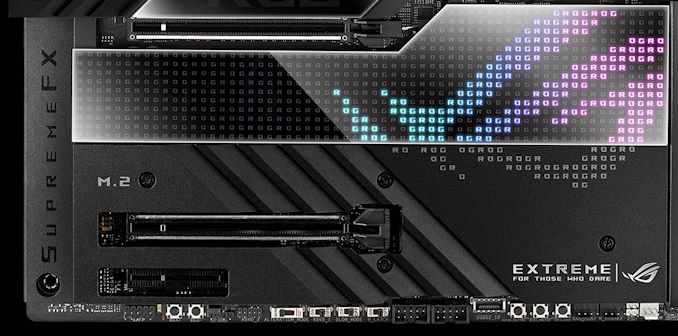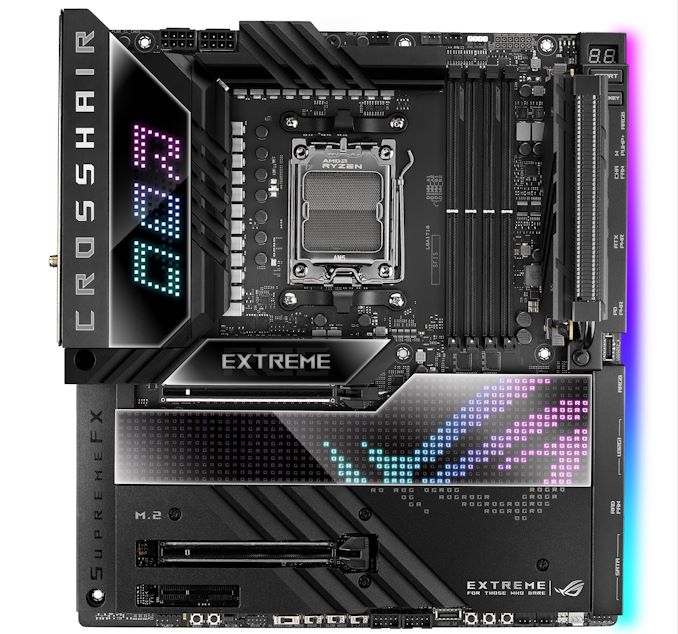Computex 2022: ASUS Unveils ROG Crosshair X670E Extreme Motherboard for Ryzen 7000
by Gavin Bonshor on May 24, 2022 9:00 AM EST
Following on from AMD's official announcement during Computex 2022 that its highly anticipated Ryzen 7000 series of processors will land sometime in Q4 2022, ASUS has lifted the lid on its flagship AM5 motherboard. Based on AMD's 'Extreme' X670 chipset variant, the ASUS ROG Crosshair X670E Extreme motherboard is fully loaded with many features, including PCIe 5.0, support for DDR5 memory, and large 22-phase power delivery for enthusiasts.
Designed to offer leading-edge performance for AMD's Ryzen 7000 processors, the ASUS ROG Crosshair X670E Extreme, ASUS has gone all out with a premium controller set and a wide array of features for users to get the most out of the new AM5 socket. This includes a typical ASUS ROG design with plenty of RGB LED lighting and its latest Q-Design features designed to make installation as easy as possible. It also benefits from an AniMe Matrix 2 LED display and ASUS's LiveDash OLED for maximum customizability.
Q-Design includes new release buttons for the PCIe slots and right-angled connectors on the right-hand side of the board for better cable management.
The ROG Crosshair X670E Extreme's main features include a large 22-phase (20+2) power delivery with premium 110 A power stages. At the same time, networking options consist of a Marvell AQtion 10 GbE controller, a secondary Intel 2.5 GbE controller, and Intel's Wi-Fi 6E CNVi. For audio, ASUS uses a ROG SupremeFX ALC4082 HD audio codec with a premium ESS Sabre ES9218PQ DAC for ultra-low distortion.
Although ASUS hasn't revealed a complete list of specifications, we know the X670E Extreme will feature two full-length PCIe 5.0 slots operating at x16/x0 or x8/x8, with a smaller PCIe slot at the bottom. It also benefits from five M.2 slots, with two of these conforming to the latest PCIe 5.0 specification and adding USB4 ports and a USB 3.2 G2x2 Type-C front panel header for connectivity. ASUS also includes a ROG M.2 add-in card next to the four DDR5 memory slots, although we don't know what type of drives these will support at the time of writing.
As we previously mentioned, ASUS hasn't unveiled the full specifications list of the ROG Crosshair X670E Extreme motherboard, nor how much it will cost. We expect ASUS to reveal more details as we head closer to AMD's Ryzen 7000 launch, expected sometime in the fall of 2022.
Source: ASUS

















7 Comments
View All Comments
shabby - Tuesday, May 24, 2022 - link
Is this exotic power delivery really necessary for a platform that barely overclocks? I don't get it.Badlipe - Tuesday, May 24, 2022 - link
It is a new platform based on a new manufacturing process that provides higher clocks...maybe you are right, but unless you have some inside information that we, mere mortals don't have access to, I don't see how you can draw that conclusion...shabby - Tuesday, May 24, 2022 - link
Just basing it off zen 3 chips, few hundred mhz overclocks and that's it.Silver5urfer - Tuesday, May 24, 2022 - link
I just hope this round AMD allows to unlock more performance out, but you know now Intel is already hitting the wall.Unlike i9 10900K the top end i9 12900K needs an AIO on stock PL2 unlocked. AIO is needed for CML processors if pushing for past 5.2GHz on a top silicon bin for all 10C20T. 12900K needs custom loop for that else it will be too hot for even AIO, that's Intel 7 which is far denser than TSMC 7N.
TSMC 5N using AMD might get a few more MHz out at the expense of heat demanding an AIO as well for 7950X assuming it's the 16C32T part. AMD should let the Boost clocks unlock at higher power, they should not hold back but their brand attraction is all about efficiency, gotta see how AMD is going to play.
OC is nearly going extinct unfortunately because both companies pushing Dynamic boosting algorithms which push the silicon to Max, hey at-least we can control them unlike the BGA dumpster or Apple silicon or Mobile phone toys.
Khanan - Tuesday, May 24, 2022 - link
TSMC 7N and “Intel 7” are nearly the same density, the Intel node is a bit denser.Overclocking will always be useful, as all core clocks will be conservative, and overclocking can force higher clocks on all cores and not just one of a few.
sonny73n - Wednesday, May 25, 2022 - link
Well, the "features include a large 22-phase (20+2) power delivery with premium 110 A power stages" is kinda extreme. Until some techie gets their hands on this board and confirms the VRM layout, I'm guessing they're using doublers because even a true 10 phase is kinda overkilled.However, VRM design is the most important part of the motherboard. Longevity and stable performance rely on good VRM components. If money is no object, I would get the motherboard with the best possible VRMs.
haukionkannel - Tuesday, May 24, 2022 - link
Auto boost has made normal OC obsolete unless you USE LN2 or other exotic cooling.That overkill power delivery could be useful again with 16 core parts that now have more headroom to keep high clock, because AMD has put the socket max voltage up.